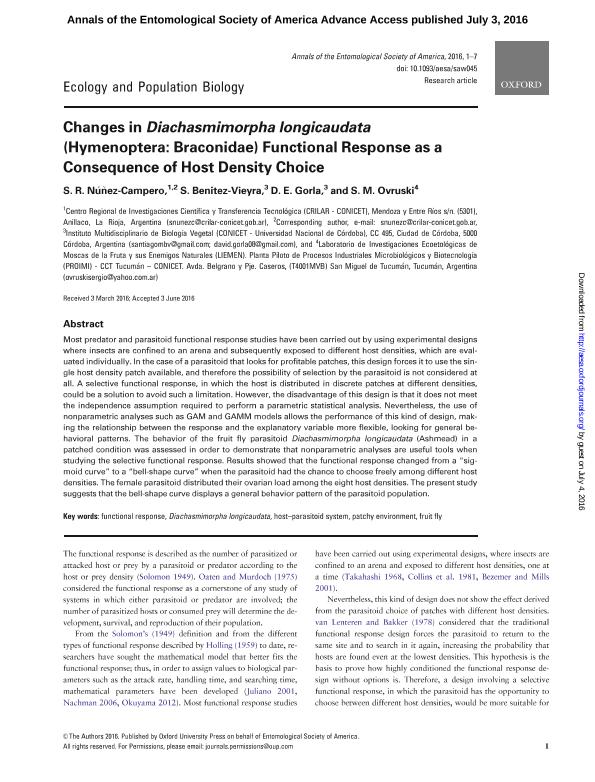Mostrar el registro sencillo del ítem
dc.contributor.author
Núñez Campero, Segundo Ricardo

dc.contributor.author
Benitez-Vieyra, Santiago Miguel

dc.contributor.author
Gorla, David Eladio

dc.contributor.author
Ovruski Alderete, Sergio Marcelo

dc.date.available
2017-09-07T17:41:17Z
dc.date.issued
2016-07
dc.identifier.citation
Núñez Campero, Segundo Ricardo; Benitez-Vieyra, Santiago Miguel; Gorla, David Eladio; Ovruski Alderete, Sergio Marcelo; Changes in Diachasmimorpha longicaudata (Hymenoptera: Braconidae) Functional Response as a Consequence of Host Density Choice; Entomological Society of America; Annals of the Entomologycal Society of America; 109; 5; 7-2016; 730-736
dc.identifier.issn
0013-8746
dc.identifier.uri
http://hdl.handle.net/11336/23778
dc.description.abstract
Most predator and parasitoid functional response studies have been carried out by using experimental designs where insects are confined to an arena and subsequently exposed to different host densities, which are evaluated individually. In the case of a parasitoid that looks for profitable patches, this design forces it to use the single host density patch available, and therefore the possibility of selection by the parasitoid is not considered at all. A selective functional response, in which the host is distributed in discrete patches at different densities,could be a solution to avoid such a limitation. However, the disadvantage of this design is that it does not meet the independence assumption required to perform a parametric statistical analysis. Nevertheless, the use of nonparametric analyses such as GAM and GAMM models allows the performance of this kind of design, making the relationship between the response and the explanatory variable more flexible, looking for general behavioral patterns. The behavior of the fruit fly parasitoid Diachasmimorpha longicaudata (Ashmead) in a patched condition was assessed in order to demonstrate that nonparametric analyses are useful tools when studying the selective functional response. Results showed that the functional response changed from a "sigmoid curve" to a "bell-shape curve" when the parasitoid had the chance to choose freely among different host densities. The female parasitoid distributed their ovarian load among the eight host densities. The present study suggests that the bell-shape curve displays a general behavior pattern of the parasitoid population.
dc.format
application/pdf
dc.language.iso
eng
dc.publisher
Entomological Society of America

dc.rights
info:eu-repo/semantics/openAccess
dc.rights.uri
https://creativecommons.org/licenses/by-nc-sa/2.5/ar/
dc.subject
Diachasmimorpha
dc.subject
Population Ecology
dc.subject
Functional Response
dc.subject.classification
Bioquímica y Biología Molecular

dc.subject.classification
Ciencias Biológicas

dc.subject.classification
CIENCIAS NATURALES Y EXACTAS

dc.title
Changes in Diachasmimorpha longicaudata (Hymenoptera: Braconidae) Functional Response as a Consequence of Host Density Choice
dc.type
info:eu-repo/semantics/article
dc.type
info:ar-repo/semantics/artículo
dc.type
info:eu-repo/semantics/publishedVersion
dc.date.updated
2017-08-29T17:32:01Z
dc.identifier.eissn
1938-2901
dc.journal.volume
109
dc.journal.number
5
dc.journal.pagination
730-736
dc.journal.pais
Estados Unidos

dc.journal.ciudad
Lanham
dc.description.fil
Fil: Núñez Campero, Segundo Ricardo. Consejo Nacional de Investigaciones Cientificas y Tecnicas. Centro Regional de Investigaciones Cientificas y Transferencia Tecnologica de la Rioja. - Universidad Nacional de la Rioja. Centro Regional de Investigaciones Cientificas y Transferencia Tecnologica de la Rioja. - Universidad Nacional de Catamarca. Centro Regional de Investigaciones Cientificas y Transferencia Tecnologica de la Rioja. - Secretaria de Industria y Mineria. Servicio Geologico Minero Argentino. Centro Regional de Investigaciones Cientificas y Transferencia Tecnologica de la Rioja. - Provincia de la Rioja. Centro Regional de Investigaciones Cientificas y Transferencia Tecnologica de la Rioja. ; Argentina; Argentina
dc.description.fil
Fil: Benitez-Vieyra, Santiago Miguel. Consejo Nacional de Investigaciones Científicas y Técnicas. Centro Científico Tecnológico Conicet - Córdoba. Instituto Multidisciplinario de Biología Vegetal. Universidad Nacional de Córdoba. Facultad de Ciencias Exactas Físicas y Naturales. Instituto Multidisciplinario de Biología Vegetal; Argentina
dc.description.fil
Fil: Gorla, David Eladio. Consejo Nacional de Investigaciones Científicas y Técnicas. Centro Científico Tecnológico Conicet - Córdoba. Instituto Multidisciplinario de Biología Vegetal. Universidad Nacional de Córdoba. Facultad de Ciencias Exactas Físicas y Naturales. Instituto Multidisciplinario de Biología Vegetal; Argentina
dc.description.fil
Fil: Ovruski Alderete, Sergio Marcelo. Consejo Nacional de Investigaciones Científicas y Técnicas. Centro Científico Tecnológico Conicet - Tucuman. Planta Piloto de Procesos Industriales Microbiologicos; Argentina
dc.journal.title
Annals of the Entomologycal Society of America

dc.relation.alternativeid
info:eu-repo/semantics/altIdentifier/doi/http://dx.doi.org/10.1093/aesa/saw045
dc.relation.alternativeid
info:eu-repo/semantics/altIdentifier/url/https://academic.oup.com/aesa/article-abstract/109/5/730/2195352/Changes-in-Diachasmimorpha-longicaudata?redirectedFrom=fulltext
Archivos asociados
